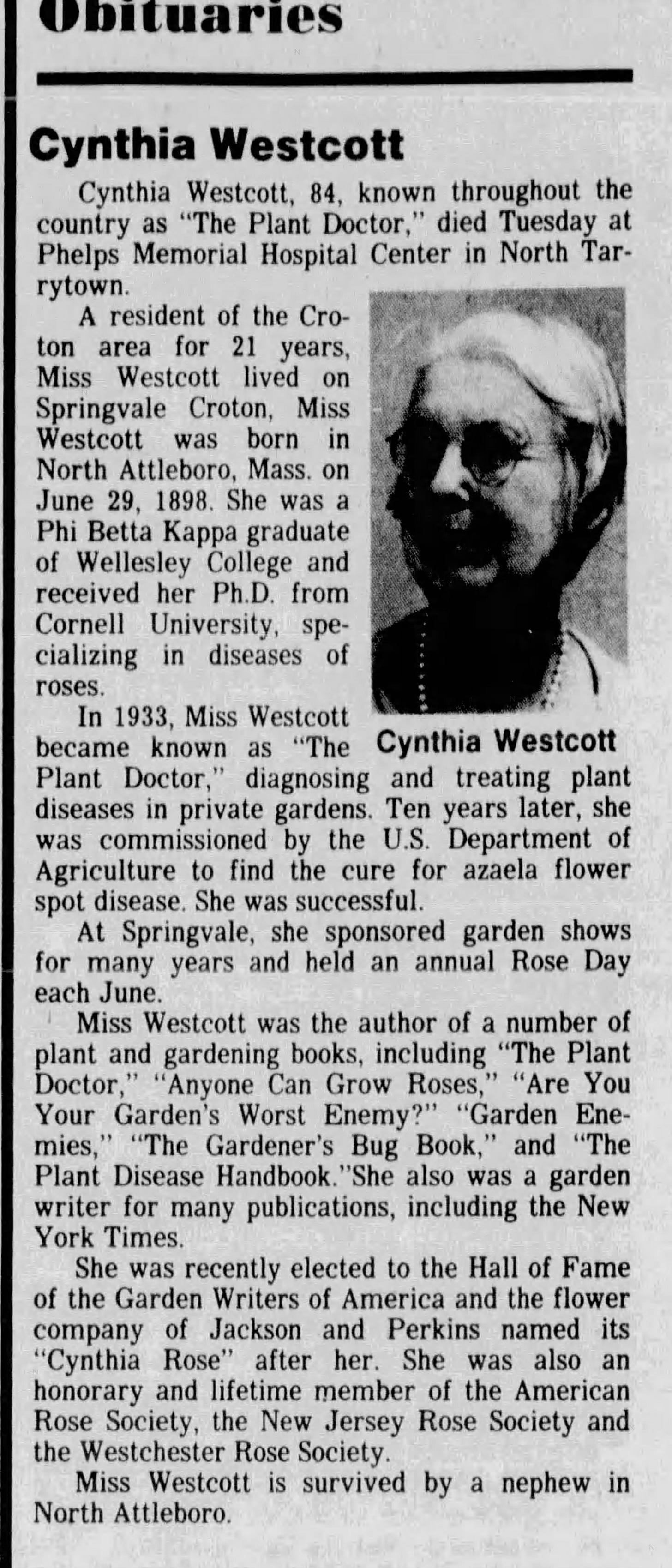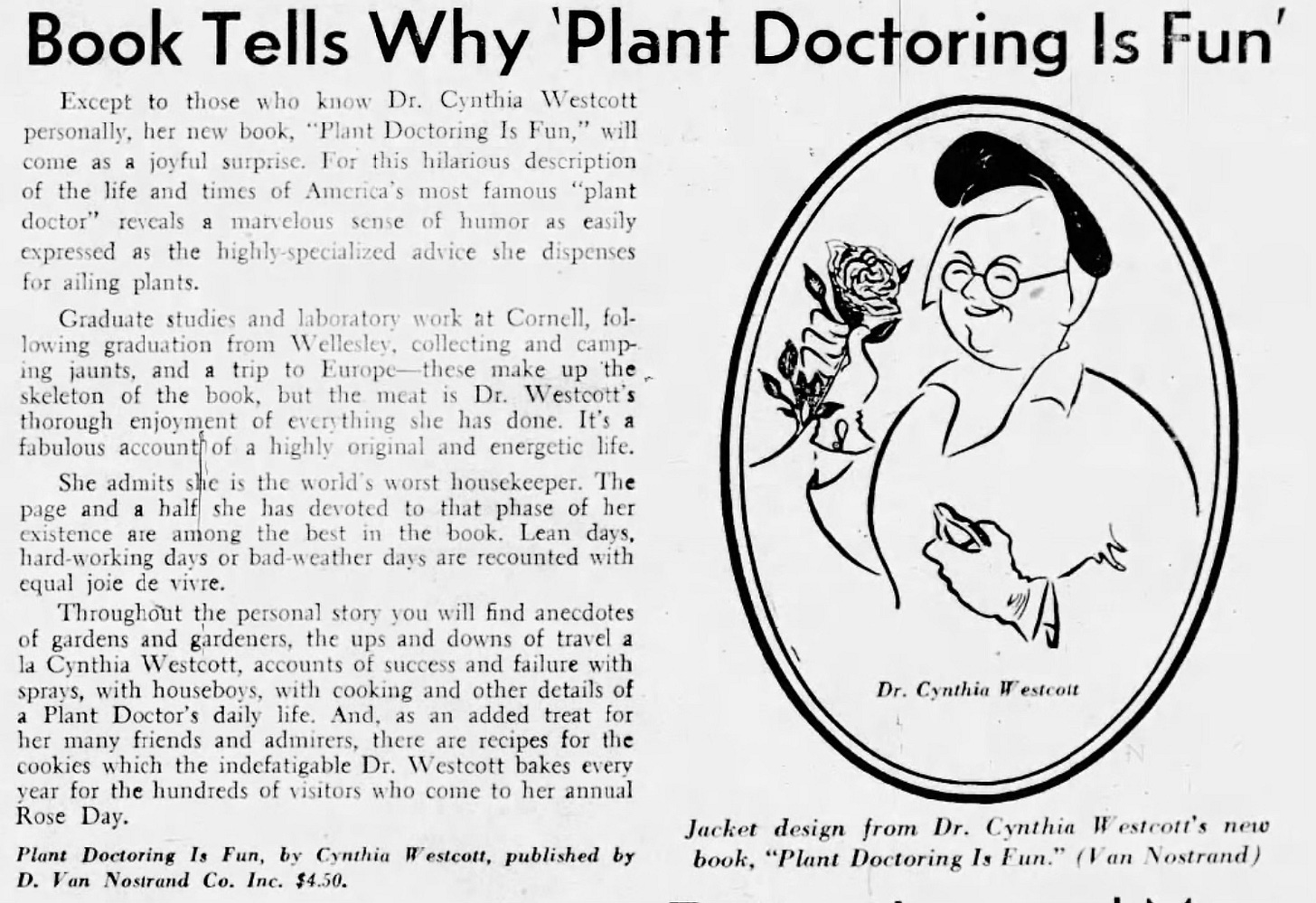Back in 2012, I wrote a blog post about Cynthia Westcott after discovering her autobiography, Plant Doctoring is Fun (1957) while on vacation. I found the book in a cavernous, kind of creepy, used bookstore on the Outer Banks of North Carolina.
It became my vacation read! I loved it.
Her Biography
A quick search will bring up Cynthia’s biography on Wikipedia. She was born in Massachusetts on June 29, 1898 to Frank and Elizabeth Westcott and had a younger brother named Frank. She graduated from Wellesley College in 1920 and then 12 years later, earned her PhD in plant pathology from Cornell University. She lived most of her adult live in Glen Ridge, NJ where she had a boarding house and her own rose gardens.
In the 1950 census, they noted her occupation as “lectures, writes, takes care of plants, horticulture.”
She never married and died on March 22, 1983. Unlike many Lost Ladies of Garden Writing, her obituary appeared in many newspapers across the country.
Her Plant Doctoring
Cynthia took a bit of a winding path through graduate school after graduating from Wellesley, but eventually, she earned her PhD in plant pathology from Cornell. After graduation, she discovered that none of the government or teaching jobs available to those with PhDs were classified as suitable for women, so she bought a house in Glen Ridge, New Jersey and hung out her shingle as “The Plant Doctor,” diagnosing diseases of ornamental plants and tending roses for her clients.
However, during WWII when most men were called into military service, she did get a government job, to “keep the seat warm” as she put it, for those who were researching ways to control “azalea petal blight.” She carried on the research and came up with the cure. She saved the azaleas of the South!
Before and after her work for the government, she took on many clients in the New York area and proceeded to live the life of a plant doctor, writer, traveler, plant disease researcher, and lecturer.
She seemed to have had no qualms about heading out to drive to Florida, Texas, and even California alone in her Model A Ford. Somehow, someone was always waiting for her at each destination, either someone she knew from college or someone who had been introduced to her by letter.
I remember as I read her autobiography, I worried a bit about her at times, not just because she traveled alone, but because of all the chemicals she used. She usually hired a helper to haul most of the equipment and pump the sprayer, but she did most of the spraying herself. She wrote, though, that she was very careful with the chemicals, avoiding spills, being careful about where she dumped extra amounts, and never leaving them out where an animal or child might get into them. I was kind of appalled about where she dumped “extra amounts” because it was usually on a gravel driveway.
Cynthia was also known for her open garden day in June. When her roses were at their peak, she’d open up her garden to show how anyone could grow roses. She sent out invitations, baked hundreds of cookies, and mixed up gallons of punch to serve to the hundreds who showed up. She even included her recipes for the cookies and punch in Plant Doctoring is Fun!
Plant Doctoring is Fun, the Book
Her autobiography was well received and I can personally share that it is a delight to read. Here’s a clip from Newsday (Nassau Edition) from September 16, 1957, singing its praises.
Her Other Books
In addition to her autobiography, Cynthia wrote several other books including:
The Plant Doctor: The How, Why, and When of Disease and Insect Control in Your Garden (1937)
The Gardener's Bug Book; 1,000 Insect Pests and Their Control (1946)
Plant Disease Handbook (1950)
Anyone Can Grow Roses (1952)
Garden Enemies (1953)
Plant Doctoring is Fun (1957)
Are You Your Garden's Worst Pest? (1961)
When I bought and read Plant Doctoring is Fun, I realized I already had one of her books, The Gardener’s Bug Book, 1973 edition. Then I found good used copies of her other books to add to my shelves, all of them except Plant Disease Handbook.
Honors and Awards
Cynthia received numerous awards and honors in her lifetime, including being named to the Garden Writers of America's Hall of Fame (now known as Garden Communicators International). GardenComm also named an honor after Cynthia, the Cynthia Westcott Scientific Writing Award. They award it to individuals with PhDs who have written books or consumer-oriented articles that help everyday gardeners learn about horticulture, just as Cynthia helped many gardeners learn to grow roses, identify insects, and treat plant diseases.
As she wrote in Plant Gardening is Fun,
“I write in the vernacular, cliches and all. I consider myself a liaison agent between the university and the home gardener. I do’’t talk down to people, I don’t patronize them, but I do try to translate what is happening in science into ordinary everyday language. And it is all filtered through my own experience both at home and across the country. I have visited gardens and talked to gardeners in nearly every state; the rest have been traversed by train.”
I think she was quite successful in doing that with her books.
Are These Old Gardening Books Still Relevant?
I was recently asked if these older gardening books, like Cynthia’s, are still relevant today. The answer is “Yes, but…” I wouldn’t follow any advice related to pesticide use. They did things differently back then. I also wouldn’t fall in love with a particular variety listed in an old book because you might not be able to find it today. For example, there is mention in Cynthia’s obituary that Jackson & Perkins named the ‘Cynthia Rose’ after her. You can still find a rose for sale named ‘Cynthia,’ but I don’t know if it is the same one! Does anyone know?
Do you know of other women authors of gardening related books that I should research as Lost Ladies of Garden Writing? Send them my way via a comment or email!
And if you find these articles interesting and think others will, too, please share them and subscribe.
I’ll return with the next Lost Lady of Garden Writing article in two weeks, on February 19th. In the meantime, you can find me in several other places online: my website and blog, The Gardenangelists podcast, and my weekly newsletter, In the Garden With Carol.








What an interesting lady! Great article.
We have some material on her in back issues of THE AZALEAN for the Azalea Society of America. I'll also share this blog post with ASA members.